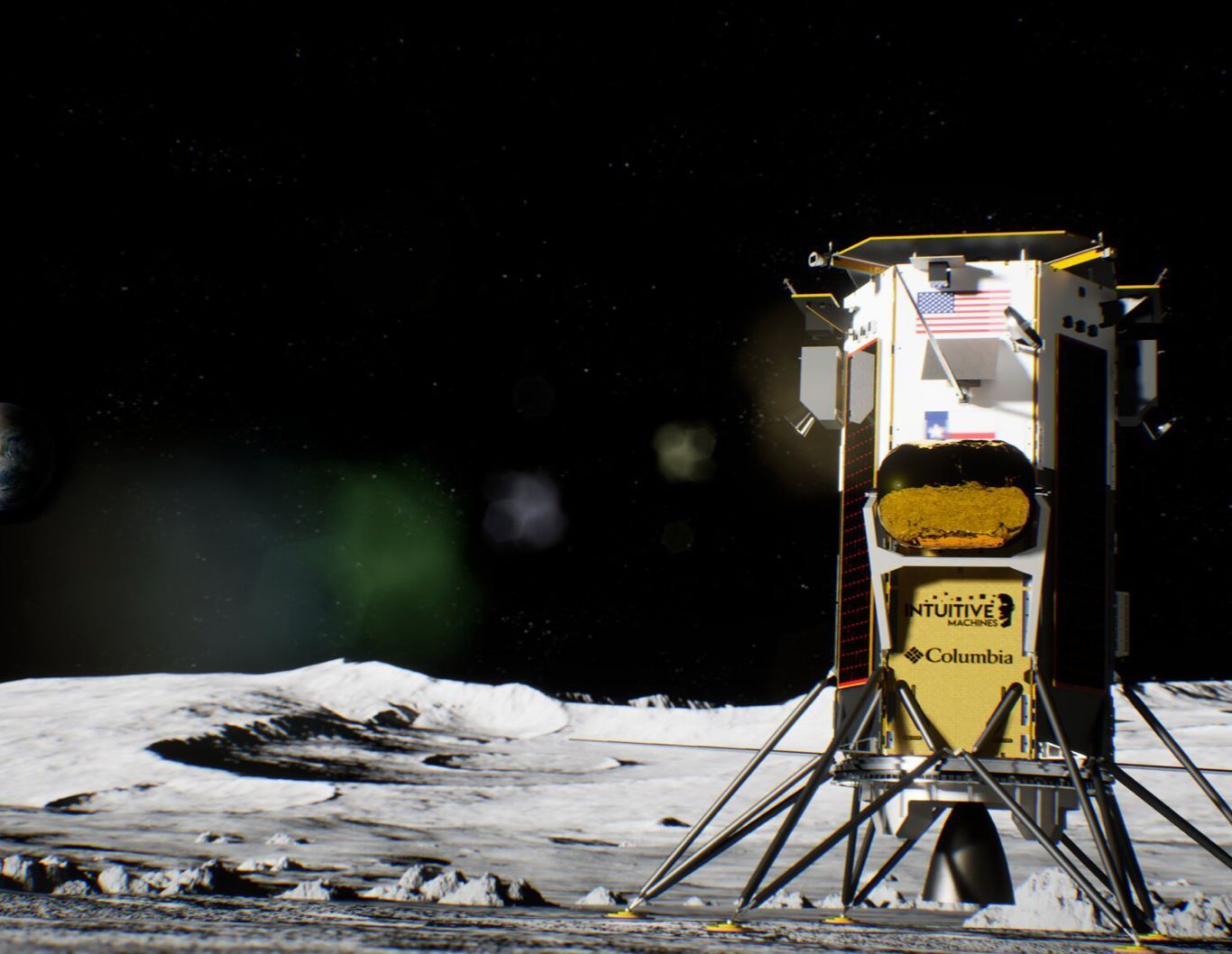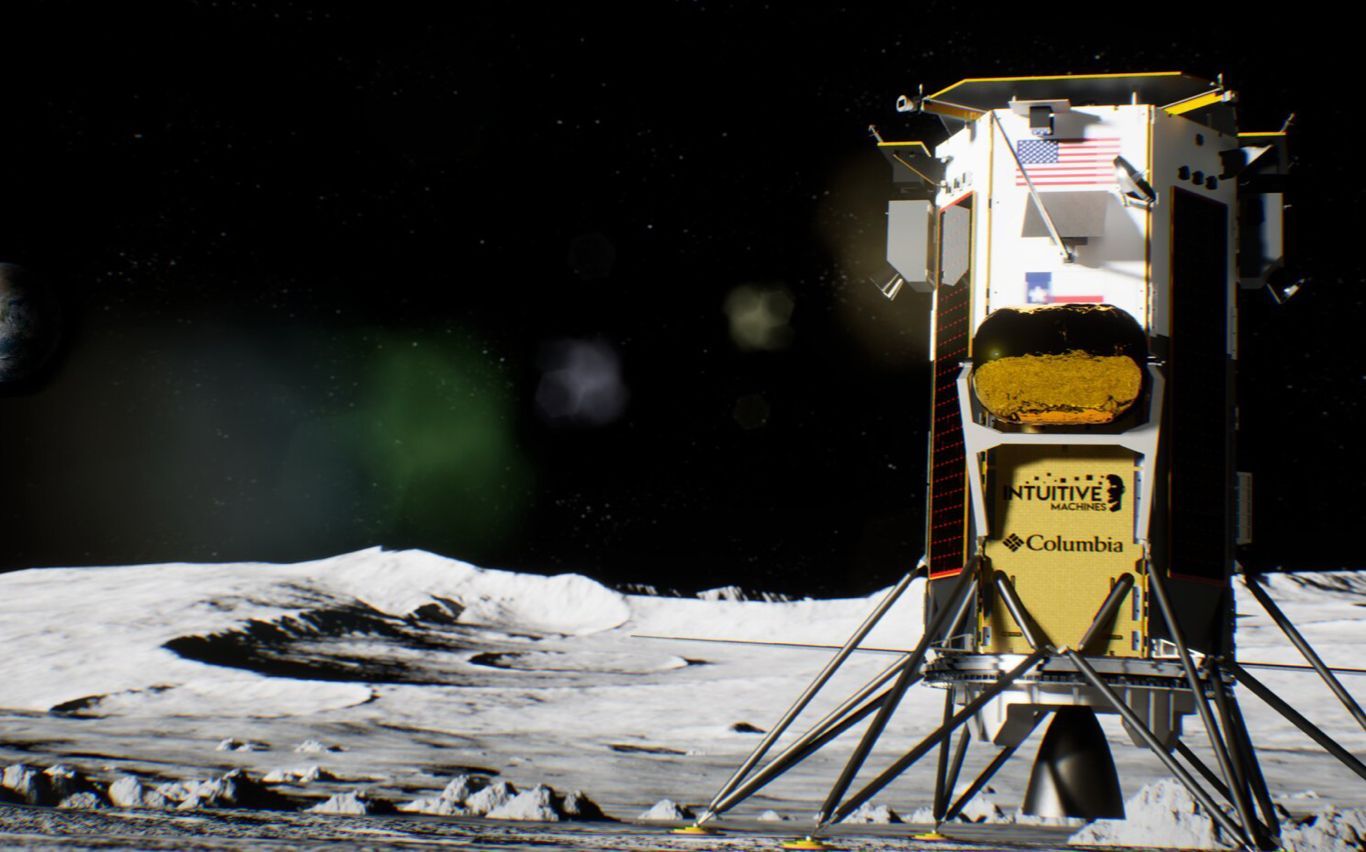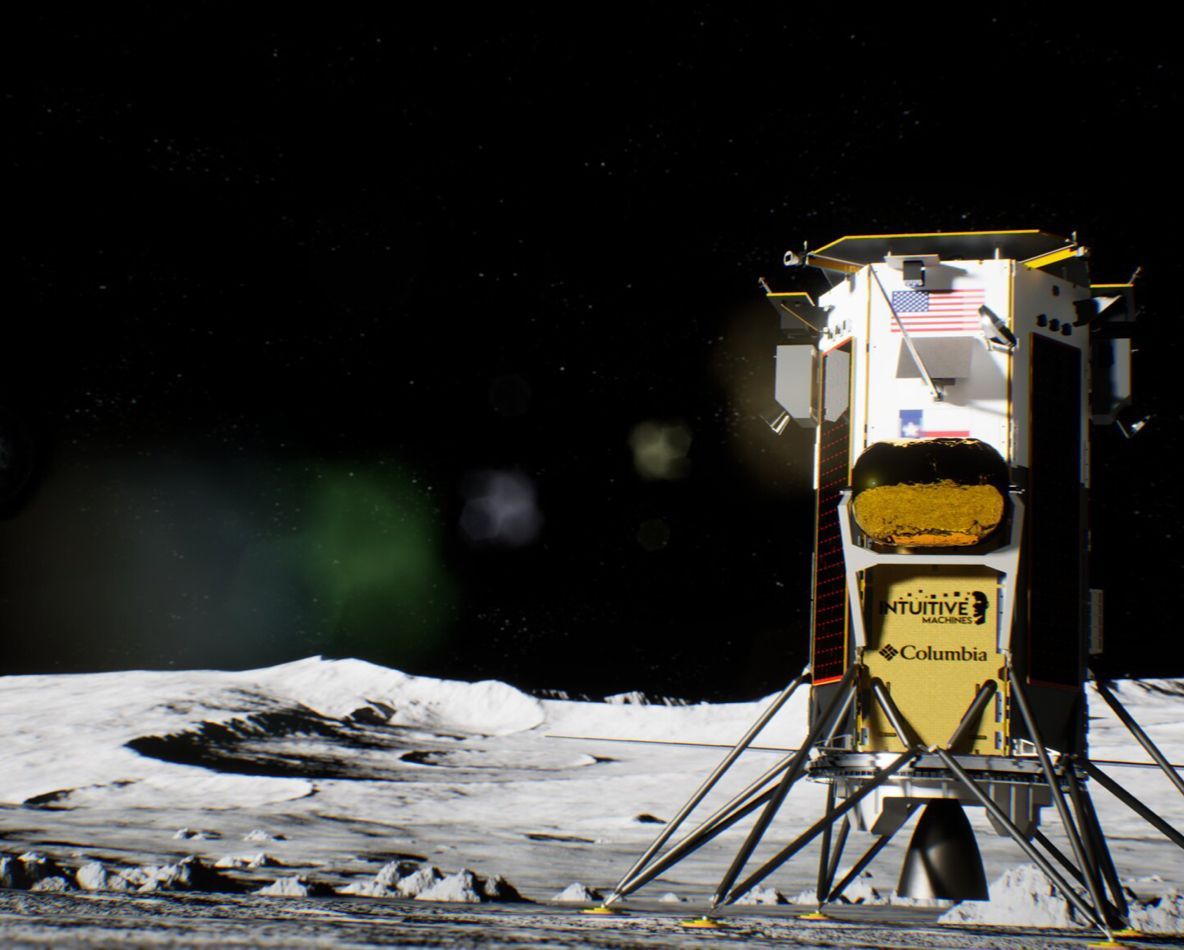14 July 2023
First for in-orbit manufacture, growth of commercial spaceflight and India race to the Moon - Space News Roundup

Varda's in-space manufacturing play role in growth of orbital infrastructure (Image: Adobe)
We’ve talked much about the emergence of in-space manufacturing, the growth of an orbital infrastructure, and the many benefits Earth-orbit can offer us. This week US-based startup Varda Space announced that they have achieved a world’s first in the successful production of pharmaceutical products on their orbiting, mini space factory. In a Twitter post the company revealed that “Over the last day, for the first time ever, orbital drug processing happened outside of a government-run space station.”
As well as drug manufacture, the preferential micro-gravity conditions could be utilised for the manufacture of such vital elements as stem cells and materials for semi-conductor production. With the dawn of commercialisation in this area, in-space manufacturing for in-demand materials could be prove to be a promising growth area in itself.
“Direct-to cell connectivity and a European communications initiative”
Australian telecommunications company Optus have announced that they plan on using SpaceX’s low Earth orbit (LEO) Starlink satellites to provide mobile connectivity in every part of the country, with 60% of the land mass currently off-grid. The satellite-to-phone coverage service is due to begin in 2024 and will start with SMS and later be expanded to voice and data coverage.
Direct-to-cell is nothing new and SpaceX have already to agreed to work with T-Mobile, using Starlink to provide direct satellite connection. Additionally, British handset maker Bullit unveiled their satellite-to-device enabled smartphone earlier this year, and Apple are already working with satellite company Globalstar to deliver SOS connectivity via satellites on their latest handsets. With the likelihood being that a large number of newer handsets will feature this service by default, and demand for it increases, we can again expect this area of the market grow quite quickly.
Similarly, this week the Global System for Mobile Communications Association (GSMA) and ESA have signed an agreement to connect the mobile and satellite industries in order to increase competitiveness, and also to explore the use of satellites in speeding up 5G and 6G networks.
China and India commit to commercial launches
In another world’s first, Chinese commercial launch company Landspace have beaten SpaceX to launch their methane-powered rocket, Zhuque-2. The launch not only represents the growing intentions of a maturing Chinese commercial space industry, but also the use of methane fuel, which is touted to be more sustainable and can increase the lifespan of reusable engines. SpaceX also opt for liquid methane for use in Starship.
Another Chinese launch startup has targeted fresh funding towards the development of their reusable commercial rocket. Space Pioneer will use the funds for its Tianlong-3 medium-lift launch vehicle, with its first liftoff slated for May 2024. It will feature a reusable first stage and claims to be comparable to SpaceX’s workhorse Falcon-9. China are already soaring into second place in the list of leading space nations, and with a thriving commercial sector, we see no signs of slowing down.
India too are looking towards their bustling private sector to support their rise as a leading space nation. Their national space agency (ISRO) is looking to transfer its Small Satellite Launch Vehicle (SSLV) rocket launcher to the private sector. SSLV is a small-lift vehicle, capable of transporting 500kg to LEO. The vehicle will completely be transferred to the private sector, not only manufacturing, and coincides with ISRO looking to increase its use of SSLV to 10 launches per year by 2026.
Increasing competition and efficiency of the private sector is answering the need for more access to space, as humankind looks to launch many thousand more objects into orbit and beyond.
Europe chases crewed launches, setbacks for Blue Origin
Beyond sending only objects into space, Europe is seeing a growing appetite for crewed launches. According to Space News, in June it was revealed that Poland have provided a further €295 million to space programmes, which will also include the finances to send a Polish astronaut to the ISS. Similarly, in April an agreement was announced that will see a Swedish astronaut join an Axiom commercial mission, also to the ISS.
This of course follows the recent commercial suborbital flight debut by Virgin Galactic, which carried crew from the Italian Air Force and National Research Council, who used the short journey to carry out scientific research in microgravity. With Europe still lacking their own sovereign launch capabilities, both crewed and un-crewed, commercial partners will be increasingly relied upon.
“SpaceX smash reusability record, while Blue Origin face setbacks”
Two companies looking to increase their presence in the European market are SpaceX and Blue Origin, the former recently launching ESA’s Euclid mission on a Falcon-9. The leading space launch provider also this week smashed their own reusability record, with the 16th launch and landing for a Falcon-9 booster on Sunday.
Reusability has drastically reduced costs and opened up the space launch market, and Blue Origin will be looking follow suit with their highly anticipated New Glenn rocket, yet to launch. However, the company face a setback as it was this week revealed that an explosion occurred while testing one of their BE-4 engines, seven of which are required for a New Glenn rocket.
Nevertheless, despite such hurdles that Blue Origin are facing, we can see that both commercialisation and reusability of rockets are key to the ongoing growth and success of New Space.

IM-1 Lander (Image: Intuitive Machines)
India in race to land on the Moon, China plan crewed landing
On Friday morning India launched their Chandrayaaan-3 lunar mission, which includes a lander and rover, and will hope it to be more successful than their failed Chandrayaan-2 mission in 2019. If they are successful, the rising space nation will become the fourth to land on the Moon.
The mission will take a longer route to the lunar surface, and the Vikram lander is due to begin its decent on August 23rd. There is the possibility that this could put the mission in a race with Russia, who recently announced that their Luna-25 mission is due to launch in August. While Luna-25 heads of much later, it takes a shorter trajectory and therefore less time to reach the surface.
Both missions will be looking to obtain samples of lunar ice, a critical component towards establishing a sustained lunar presence. In-situ resource utilisation of water and lunar soil will be vital for the production of such things as fuel and oxygen.
“Commercial entities in lunar race, China reveal details”
Private companies are among other entities looking to land on the Moon within the next 12 months. US-based Astrobotic are still aiming to send their Peregrine lander to the Moon this year as part of ULA’s maiden Vulcan launch. They were scheduled for Q3 of this year, but will now slip back further to Q4 after ULA announced on Thursday they will need to complete modifications and testing to the upper stage. Also, speaking to reporters on July 13, Tory Bruno, president and chief executive of ULA, played down the impact that the BE-4 engine explosion might have on their schedule, saying that the engines are already qualified for use in Vulcan.
Also based in the US, Intuitive Machines will look to launch their IM-1 lander in Q3 of this year, and also ambitiously are aiming to launch their IM-2 lander before the end of 2023. The company are currently working with SpaceX as their launch partner for IM-1 and on Thursday announced a successful spacecraft test run of the lander, which could keep it on course to launch this quarter.
Lastly, China announced on Wednesday that it has laid out preliminary plans to land its taikonauts on the lunar surface before 2030. The ambitious plans include sending two rockets; one to send a lunar lander, one to carry crew, into lunar orbit. Once in orbit they will then dock and the taikonauts will enter the lander and then descend towards the surface.
China’s Moon missions form part of the bigger International Lunar Research Station plans, their long-term vision for a sustained presence on the lunar surface. Lunar missions such as those from India and Russia will play a vital role in learning how to achieve such long-term goals. Moreover, what we are seeing, week-in and week-out, is the expanding role played by the commercial sector, in developing an accessible launch market, space products for the benefit of humankind, and expanding commercialisation into outer space.
External Links
This Week
*News articles posted here are not property of ANASDA GmbH and belong to their respected owners. Postings here are external links only.
Our future in space

(Varda's in-space manufacturing play role in growth of orbital infrastructure (Image: Adobe)
14 July 2023
First for in-orbit manufacture, growth of commercial spaceflight and India race to the Moon - Space News Roundup
We’ve talked much about the emergence of in-space manufacturing, the growth of an orbital infrastructure, and the many benefits Earth-orbit can offer us. This week US-based startup Varda Space announced that they have achieved a world’s first in the successful production of pharmaceutical products on their orbiting, mini space factory. In a Twitter post the company revealed that “Over the last day, for the first time ever, orbital drug processing happened outside of a government-run space station.”
As well as drug manufacture, the preferential micro-gravity conditions could be utilised for the manufacture of such vital elements as stem cells and materials for semi-conductor production. With the dawn of commercialisation in this area, in-space manufacturing for in-demand materials could be prove to be a promising growth area in itself.
“Direct-to cell connectivity and a European communications initiative”
Australian telecommunications company Optus have announced that they plan on using SpaceX’s low Earth orbit (LEO) Starlink satellites to provide mobile connectivity in every part of the country, with 60% of the land mass currently off-grid. The satellite-to-phone coverage service is due to begin in 2024 and will start with SMS and later be expanded to voice and data coverage.
Direct-to-cell is nothing new and SpaceX have already to agreed to work with T-Mobile, using Starlink to provide direct satellite connection. Additionally, British handset maker Bullit unveiled their satellite-to-device enabled smartphone earlier this year, and Apple are already working with satellite company Globalstar to deliver SOS connectivity via satellites on their latest handsets. With the likelihood being that a large number of newer handsets will feature this service by default, and demand for it increases, we can again expect this area of the market grow quite quickly.
Similarly, this week the Global System for Mobile Communications Association (GSMA) and ESA have signed an agreement to connect the mobile and satellite industries in order to increase competitiveness, and also to explore the use of satellites in speeding up 5G and 6G networks.
China and India commit to commercial launches
In another world’s first, Chinese commercial launch company Landspace have beaten SpaceX to launch their methane-powered rocket, Zhuque-2. The launch not only represents the growing intentions of a maturing Chinese commercial space industry, but also the use of methane fuel, which is touted to be more sustainable and can increase the lifespan of reusable engines. SpaceX also opt for liquid methane for use in Starship.
Another Chinese launch startup has targeted fresh funding towards the development of their reusable commercial rocket. Space Pioneer will use the funds for its Tianlong-3 medium-lift launch vehicle, with its first liftoff slated for May 2024. It will feature a reusable first stage and claims to be comparable to SpaceX’s workhorse Falcon-9. China are already soaring into second place in the list of leading space nations, and with a thriving commercial sector, we see no signs of slowing down.
India too are looking towards their bustling private sector to support their rise as a leading space nation. Their national space agency (ISRO) is looking to transfer its Small Satellite Launch Vehicle (SSLV) rocket launcher to the private sector. SSLV is a small-lift vehicle, capable of transporting 500kg to LEO. The vehicle will completely be transferred to the private sector, not only manufacturing, and coincides with ISRO looking to increase its use of SSLV to 10 launches per year by 2026.
Increasing competition and efficiency of the private sector is answering the need for more access to space, as humankind looks to launch many thousand more objects into orbit and beyond.
Europe chases crewed launches, setbacks for Blue Origin
Beyond sending only objects into space, Europe is seeing a growing appetite for crewed launches. According to Space News, in June it was revealed that Poland have provided a further €295 million to space programmes, which will also include the finances to send a Polish astronaut to the ISS. Similarly, in April an agreement was announced that will see a Swedish astronaut join an Axiom commercial mission, also to the ISS.
This of course follows the recent commercial suborbital flight debut by Virgin Galactic, which carried crew from the Italian Air Force and National Research Council, who used the short journey to carry out scientific research in microgravity. With Europe still lacking their own sovereign launch capabilities, both crewed and un-crewed, commercial partners will be increasingly relied upon.
“SpaceX smash reusability record, while Blue Origin face setbacks”
Two companies looking to increase their presence in the European market are SpaceX and Blue Origin, the former recently launching ESA’s Euclid mission on a Falcon-9. The leading space launch provider also this week smashed their own reusability record, with the 16th launch and landing for a Falcon-9 booster on Sunday.
Reusability has drastically reduced costs and opened up the space launch market, and Blue Origin will be looking follow suit with their highly anticipated New Glenn rocket, yet to launch. However, the company face a setback as it was this week revealed that an explosion occurred while testing one of their BE-4 engines, seven of which are required for a New Glenn rocket.
Nevertheless, despite such hurdles that Blue Origin are facing, we can see that both commercialisation and reusability of rockets are key to the ongoing growth and success of New Space.

IM-1 Lander (Image: Intuitive Machines)
India in race to land on the Moon, China plan crewed landing
On Friday morning India launched their Chandrayaaan-3 lunar mission, which includes a lander and rover, and will hope it to be more successful than their failed Chandrayaan-2 mission in 2019. If they are successful, the rising space nation will become the fourth to land on the Moon.
The mission will take a longer route to the lunar surface, and the Vikram lander is due to begin its decent on August 23rd. There is the possibility that this could put the mission in a race with Russia, who recently announced that their Luna-25 mission is due to launch in August. While Luna-25 heads of much later, it takes a shorter trajectory and therefore less time to reach the surface.
Both missions will be looking to obtain samples of lunar ice, a critical component towards establishing a sustained lunar presence. In-situ resource utilisation of water and lunar soil will be vital for the production of such things as fuel and oxygen.
“Commercial entities in lunar race, China reveal details”
Private companies are among other entities looking to land on the Moon within the next 12 months. US-based Astrobotic are still aiming to send their Peregrine lander to the Moon this year as part of ULA’s maiden Vulcan launch. They were scheduled for Q3 of this year, but will now slip back further to Q4 after ULA announced on Thursday they will need to complete modifications and testing to the upper stage. Also, speaking to reporters on July 13, Tory Bruno, president and chief executive of ULA, played down the impact that the BE-4 engine explosion might have on their schedule, saying that the engines are already qualified for use in Vulcan.
Also based in the US, Intuitive Machines will look to launch their IM-1 lander in Q3 of this year, and also ambitiously are aiming to launch their IM-2 lander before the end of 2023. The company are currently working with SpaceX as their launch partner for IM-1 and on Thursday announced a successful spacecraft test run of the lander, which could keep it on course to launch this quarter.
Lastly, China announced on Wednesday that it has laid out preliminary plans to land its taikonauts on the lunar surface before 2030. The ambitious plans include sending two rockets; one to send a lunar lander, one to carry crew, into lunar orbit. Once in orbit they will then dock and the taikonauts will enter the lander and then descend towards the surface.
China’s Moon missions form part of the bigger International Lunar Research Station plans, their long-term vision for a sustained presence on the lunar surface. Lunar missions such as those from India and Russia will play a vital role in learning how to achieve such long-term goals. Moreover, what we are seeing, week-in and week-out, is the expanding role played by the commercial sector, in developing an accessible launch market, space products for the benefit of humankind, and expanding commercialisation into outer space.
Share this article
External Links
This Week
*News articles posted here are not property of ANASDA GmbH and belong to their respected owners. Postings here are external links only.
14 July 2023
First for in-orbit manufacture, growth of commercial spaceflight and India race to the Moon - Space News Roundup

Varda's in-space manufacturing play role in growth of orbital infrastructure (Image: Adobe)
We’ve talked much about the emergence of in-space manufacturing, the growth of an orbital infrastructure, and the many benefits Earth-orbit can offer us. This week US-based startup Varda Space announced that they have achieved a world’s first in the successful production of pharmaceutical products on their orbiting, mini space factory. In a Twitter post the company revealed that “Over the last day, for the first time ever, orbital drug processing happened outside of a government-run space station.”
As well as drug manufacture, the preferential micro-gravity conditions could be utilised for the manufacture of such vital elements as stem cells and materials for semi-conductor production. With the dawn of commercialisation in this area, in-space manufacturing for in-demand materials could be prove to be a promising growth area in itself.
“Direct-to cell connectivity and a European communications initiative”
Australian telecommunications company Optus have announced that they plan on using SpaceX’s low Earth orbit (LEO) Starlink satellites to provide mobile connectivity in every part of the country, with 60% of the land mass currently off-grid. The satellite-to-phone coverage service is due to begin in 2024 and will start with SMS and later be expanded to voice and data coverage.
Direct-to-cell is nothing new and SpaceX have already to agreed to work with T-Mobile, using Starlink to provide direct satellite connection. Additionally, British handset maker Bullit unveiled their satellite-to-device enabled smartphone earlier this year, and Apple are already working with satellite company Globalstar to deliver SOS connectivity via satellites on their latest handsets. With the likelihood being that a large number of newer handsets will feature this service by default, and demand for it increases, we can again expect this area of the market grow quite quickly.
Similarly, this week the Global System for Mobile Communications Association (GSMA) and ESA have signed an agreement to connect the mobile and satellite industries in order to increase competitiveness, and also to explore the use of satellites in speeding up 5G and 6G networks.
China and India commit to commercial launches
In another world’s first, Chinese commercial launch company Landspace have beaten SpaceX to launch their methane-powered rocket, Zhuque-2. The launch not only represents the growing intentions of a maturing Chinese commercial space industry, but also the use of methane fuel, which is touted to be more sustainable and can increase the lifespan of reusable engines. SpaceX also opt for liquid methane for use in Starship.
Another Chinese launch startup has targeted fresh funding towards the development of their reusable commercial rocket. Space Pioneer will use the funds for its Tianlong-3 medium-lift launch vehicle, with its first liftoff slated for May 2024. It will feature a reusable first stage and claims to be comparable to SpaceX’s workhorse Falcon-9. China are already soaring into second place in the list of leading space nations, and with a thriving commercial sector, we see no signs of slowing down.
India too are looking towards their bustling private sector to support their rise as a leading space nation. Their national space agency (ISRO) is looking to transfer its Small Satellite Launch Vehicle (SSLV) rocket launcher to the private sector. SSLV is a small-lift vehicle, capable of transporting 500kg to LEO. The vehicle will completely be transferred to the private sector, not only manufacturing, and coincides with ISRO looking to increase its use of SSLV to 10 launches per year by 2026.
Increasing competition and efficiency of the private sector is answering the need for more access to space, as humankind looks to launch many thousand more objects into orbit and beyond.
Europe chases crewed launches, setbacks for Blue Origin
Beyond sending only objects into space, Europe is seeing a growing appetite for crewed launches. According to Space News, in June it was revealed that Poland have provided a further €295 million to space programmes, which will also include the finances to send a Polish astronaut to the ISS. Similarly, in April an agreement was announced that will see a Swedish astronaut join an Axiom commercial mission, also to the ISS.
This of course follows the recent commercial suborbital flight debut by Virgin Galactic, which carried crew from the Italian Air Force and National Research Council, who used the short journey to carry out scientific research in microgravity. With Europe still lacking their own sovereign launch capabilities, both crewed and un-crewed, commercial partners will be increasingly relied upon.
“SpaceX smash reusability record, while Blue Origin face setbacks”
Two companies looking to increase their presence in the European market are SpaceX and Blue Origin, the former recently launching ESA’s Euclid mission on a Falcon-9. The leading space launch provider also this week smashed their own reusability record, with the 16th launch and landing for a Falcon-9 booster on Sunday.
Reusability has drastically reduced costs and opened up the space launch market, and Blue Origin will be looking follow suit with their highly anticipated New Glenn rocket, yet to launch. However, the company face a setback as it was this week revealed that an explosion occurred while testing one of their BE-4 engines, seven of which are required for a New Glenn rocket.
Nevertheless, despite such hurdles that Blue Origin are facing, we can see that both commercialisation and reusability of rockets are key to the ongoing growth and success of New Space.

IM-1 Lander (Image: Intuitive Machines)
India in race to land on the Moon, China plan crewed landing
On Friday morning India launched their Chandrayaaan-3 lunar mission, which includes a lander and rover, and will hope it to be more successful than their failed Chandrayaan-2 mission in 2019. If they are successful, the rising space nation will become the fourth to land on the Moon.
The mission will take a longer route to the lunar surface, and the Vikram lander is due to begin its decent on August 23rd. There is the possibility that this could put the mission in a race with Russia, who recently announced that their Luna-25 mission is due to launch in August. While Luna-25 heads of much later, it takes a shorter trajectory and therefore less time to reach the surface.
Both missions will be looking to obtain samples of lunar ice, a critical component towards establishing a sustained lunar presence. In-situ resource utilisation of water and lunar soil will be vital for the production of such things as fuel and oxygen.
“Commercial entities in lunar race, China reveal details”
Private companies are among other entities looking to land on the Moon within the next 12 months. US-based Astrobotic are still aiming to send their Peregrine lander to the Moon this year as part of ULA’s maiden Vulcan launch. They were scheduled for Q3 of this year, but will now slip back further to Q4 after ULA announced on Thursday they will need to complete modifications and testing to the upper stage. Also, speaking to reporters on July 13, Tory Bruno, president and chief executive of ULA, played down the impact that the BE-4 engine explosion might have on their schedule, saying that the engines are already qualified for use in Vulcan.
Also based in the US, Intuitive Machines will look to launch their IM-1 lander in Q3 of this year, and also ambitiously are aiming to launch their IM-2 lander before the end of 2023. The company are currently working with SpaceX as their launch partner for IM-1 and on Thursday announced a successful spacecraft test run of the lander, which could keep it on course to launch this quarter.
Lastly, China announced on Wednesday that it has laid out preliminary plans to land its taikonauts on the lunar surface before 2030. The ambitious plans include sending two rockets; one to send a lunar lander, one to carry crew, into lunar orbit. Once in orbit they will then dock and the taikonauts will enter the lander and then descend towards the surface.
China’s Moon missions form part of the bigger International Lunar Research Station plans, their long-term vision for a sustained presence on the lunar surface. Lunar missions such as those from India and Russia will play a vital role in learning how to achieve such long-term goals. Moreover, what we are seeing, week-in and week-out, is the expanding role played by the commercial sector, in developing an accessible launch market, space products for the benefit of humankind, and expanding commercialisation into outer space.
Share this article
External Links
This Week
*News articles posted here are not property of ANASDA GmbH and belong to their respected owners. Postings here are external links only.















